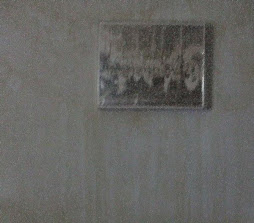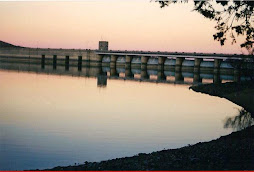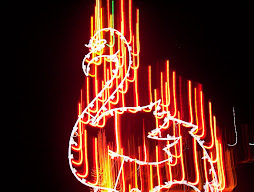Radioactivity at intake of No.3 reactor rises NHK via Rense. Excerpts:
Radioactive materials in the ocean near the Fukushima Daiichi nuclear power plant rose to 3,300 times the legal limit on Sunday.
Tokyo Electric Power Company says it measured 200 becquerels of cesium-134 per cubic centimeter on Sunday morning near the water intake of the No. 3 reactor. The level was higher than on the previous day, when it was 2,300 times the legal limit.
220 becquerels of cesium-137 per cubic centimeter was also detected. At 2,400 times the legal limit, the level exceeded the one found the day before.
On Wednesday, highly radioactive water was found leaking into the ocean from a pit located near the water intake of the No. 3 reactor. 32,000 times the legal limit of cesium-134 was detected there.
Was Fukushima a China Syndrome? From Time(!). Hey, thanks for showing up--Two months later.. Excerpts:
The China Syndrome refers to a scenario in which a molten nuclear reactor core could could fission its way through its containment vessel, melt through the basement of the power plant and down into the earth. While a molten reactor core wouldn't burn "all the way through to China" it could enter the soil and water table and cause huge contamination in the crops and drinking water around the power plant. It's a nightmare scenario, the stuff of movies. And it might just have happened at Fukushima.
Forensic Medical Global Analysis Of Fukushima Daiichi Crisis From Rense. Excerpts:
The shroud of mystery is dropping and the horror of all three reactors having a complete core breach, reactor cooling pool to Unit 4 blown sky-high and Arne Gundersen analysis of MOX Unit 3 cooling pool going hypercritical with a hydrogen trigger nuclear explosion. Up to 50 km away from the plant debris with highly radioactive soil has been revealed. The Pacific Ocean is a TEPCO Fukushima dumping ground, with the Humbolt or Black Current carrying toxic death to Alaska, Canada, Washington, Oregon, California and Baja California.
..
We had a flurry of concern early, but now the sound of a slumbering population is deafening with apathy and fanciful thoughts that all is well in our air, food, water and we should listen to the EPA. Now, the radiation on my North County, San Diego, CA, Inspector PLUS shows daily waves of radiation with CPM climbing and falling over hours with low 20s to middle 50s when it rains, mists or just when a new cloud of nanoparticles arrives fresh from the inept exploits of TEPCO in Northern Japan.
The new enervated Tepco Sentaku Magazine via Godlike Productions. Further evidence as to TEPCO's and the Japanese Government's homicidal negligence towards the rest of the World. Thanks, jerks.. Excerpts:
With the onset of the Fukushima No. 1 nuclear power plant crisis following the March 11 Tohoku-Pacific earthquake, radioactive substances continue to seep into the sea, air and soil. Residents within a designated proximity of the plant will likely have to live away from their homes a long time. The prospect of the situation returning to normal is nowhere in sight.
Although the government and Tokyo Electric Power Co. (Tepco), the operator of the ill-fated plant, have worked out plans to pay compensation to victims of the crisis, it appears they are interested less in protecting people from radiation than in preserving the existing semi-monopolistic system of the power industry and in enabling the government of Prime Minister Naoto Kan to survive.
Tepco is now attempting to divert public opinion away from its responsibility for the nuclear crisis to the need to secure a stable supply of electricity. Shortly after its Fukushima power station was damaged, the company announced that it would have to impose "planned rolling power outages" to make up for reduced power generation.
By emphasizing that abandoning nuclear power generation would lead to prolonged outages, Tepco sought to convince the public that it is better to rely on nuclear power generation than endure power outages and that it is time to help Tepco with public funds. This is an ultimate form of defiance by Tepco.
Industrial circles, especially manufacturing, were thrown into a panic by the government's plan to make it mandatory for major electric power users to reduce consumption by 25 percent this summer. This could be a matter of life and death for manufacturers whose activities are already hindered by the disruption of production at component suppliers located in areas devastated by the earthquake and tsunami. This fear has served to change the attitude of the business community from one of criticizing Tepco to seeking stable power supply.
Japan keeps Fukushima shutdown target despite setbacks
Japan on Tuesday will unveil new plans to contain the crisis at a crippled nuclear plant after admitting it faced more serious challenges than first disclosed, but was expected to stick to a timetable for bringing the reactors under control by January.
More than two months after the worst nuclear disaster since Chernobyl, officials say the risk of another explosion at the Fukushima plant has declined but each step toward taking control has been matched by new setbacks. The crisis has also prompted a blank-slate review of Japan's national energy policy.
..
Prime Minister Naoto Kan has said the timetable would be unchanged and other officials have sketched out the new methods which would in particular focus on how to clean up the large amount of water contaminated by radiation.
The timetable for taking control of the Fukushima Daiichi crisis has been politically charged and faced skepticism from the start.
Radioactive materials in the ocean near the Fukushima Daiichi nuclear power plant rose to 3,300 times the legal limit on Sunday.
Tokyo Electric Power Company says it measured 200 becquerels of cesium-134 per cubic centimeter on Sunday morning near the water intake of the No. 3 reactor. The level was higher than on the previous day, when it was 2,300 times the legal limit.
220 becquerels of cesium-137 per cubic centimeter was also detected. At 2,400 times the legal limit, the level exceeded the one found the day before.
On Wednesday, highly radioactive water was found leaking into the ocean from a pit located near the water intake of the No. 3 reactor. 32,000 times the legal limit of cesium-134 was detected there.
Was Fukushima a China Syndrome? From Time(!). Hey, thanks for showing up--Two months later.. Excerpts:
The China Syndrome refers to a scenario in which a molten nuclear reactor core could could fission its way through its containment vessel, melt through the basement of the power plant and down into the earth. While a molten reactor core wouldn't burn "all the way through to China" it could enter the soil and water table and cause huge contamination in the crops and drinking water around the power plant. It's a nightmare scenario, the stuff of movies. And it might just have happened at Fukushima.
Forensic Medical Global Analysis Of Fukushima Daiichi Crisis From Rense. Excerpts:
The shroud of mystery is dropping and the horror of all three reactors having a complete core breach, reactor cooling pool to Unit 4 blown sky-high and Arne Gundersen analysis of MOX Unit 3 cooling pool going hypercritical with a hydrogen trigger nuclear explosion. Up to 50 km away from the plant debris with highly radioactive soil has been revealed. The Pacific Ocean is a TEPCO Fukushima dumping ground, with the Humbolt or Black Current carrying toxic death to Alaska, Canada, Washington, Oregon, California and Baja California.
..
We had a flurry of concern early, but now the sound of a slumbering population is deafening with apathy and fanciful thoughts that all is well in our air, food, water and we should listen to the EPA. Now, the radiation on my North County, San Diego, CA, Inspector PLUS shows daily waves of radiation with CPM climbing and falling over hours with low 20s to middle 50s when it rains, mists or just when a new cloud of nanoparticles arrives fresh from the inept exploits of TEPCO in Northern Japan.
The new enervated Tepco Sentaku Magazine via Godlike Productions. Further evidence as to TEPCO's and the Japanese Government's homicidal negligence towards the rest of the World. Thanks, jerks.. Excerpts:
With the onset of the Fukushima No. 1 nuclear power plant crisis following the March 11 Tohoku-Pacific earthquake, radioactive substances continue to seep into the sea, air and soil. Residents within a designated proximity of the plant will likely have to live away from their homes a long time. The prospect of the situation returning to normal is nowhere in sight.
Although the government and Tokyo Electric Power Co. (Tepco), the operator of the ill-fated plant, have worked out plans to pay compensation to victims of the crisis, it appears they are interested less in protecting people from radiation than in preserving the existing semi-monopolistic system of the power industry and in enabling the government of Prime Minister Naoto Kan to survive.
Tepco is now attempting to divert public opinion away from its responsibility for the nuclear crisis to the need to secure a stable supply of electricity. Shortly after its Fukushima power station was damaged, the company announced that it would have to impose "planned rolling power outages" to make up for reduced power generation.
By emphasizing that abandoning nuclear power generation would lead to prolonged outages, Tepco sought to convince the public that it is better to rely on nuclear power generation than endure power outages and that it is time to help Tepco with public funds. This is an ultimate form of defiance by Tepco.
Industrial circles, especially manufacturing, were thrown into a panic by the government's plan to make it mandatory for major electric power users to reduce consumption by 25 percent this summer. This could be a matter of life and death for manufacturers whose activities are already hindered by the disruption of production at component suppliers located in areas devastated by the earthquake and tsunami. This fear has served to change the attitude of the business community from one of criticizing Tepco to seeking stable power supply.
Japan keeps Fukushima shutdown target despite setbacks
Japan on Tuesday will unveil new plans to contain the crisis at a crippled nuclear plant after admitting it faced more serious challenges than first disclosed, but was expected to stick to a timetable for bringing the reactors under control by January.
More than two months after the worst nuclear disaster since Chernobyl, officials say the risk of another explosion at the Fukushima plant has declined but each step toward taking control has been matched by new setbacks. The crisis has also prompted a blank-slate review of Japan's national energy policy.
..
Prime Minister Naoto Kan has said the timetable would be unchanged and other officials have sketched out the new methods which would in particular focus on how to clean up the large amount of water contaminated by radiation.
The timetable for taking control of the Fukushima Daiichi crisis has been politically charged and faced skepticism from the start.









































































































No comments:
Post a Comment